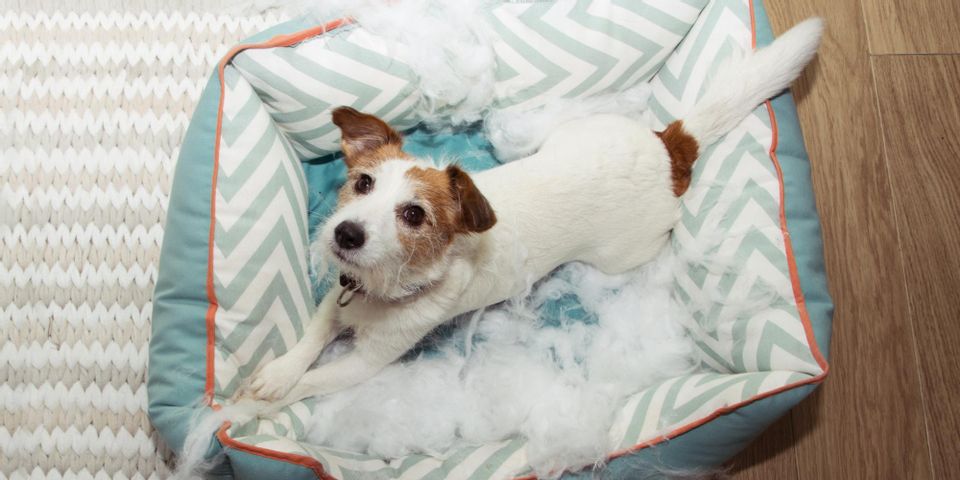How to Deal with Your Dog's Separation Anxiety - Part 3

In the last two posts, we talked about separation anxiety as a true phobia, and how human phobias are treated.
So how do we apply this to dogs?
First, we can’t be in a hurry. Counter-conditioning takes months of work. Everyone wants the “magic pill” that will end the issue, but phobias don’t respond to pills. How much Prozac would it take to make it ok to work in the Hospital of a Thousand Tarantulas? It’s a pretty safe drug, but not at the quantities I’d need. Meds can help ease the transition, but there is no magic anti-phobia pill.
The answer is slow, controlled exposure.
Plan to start this at a time when you won’t be leaving for a while, if possible. If you do have to leave your dog alone while going through this regime, use a secure crate. We will not be using a crate for our training, so he will eventually figure out the difference between training time and crate time, and one day the crate will be gone for good. Meanwhile, keep him and your home safe when you have to leave him alone.
Here we go.
Day one.
First, turn on the TV, or make sure you have your phone or laptop ready. You’ll be sitting in one place for a while, so be ready with something to do.
Remember that this is a training time, so don’t start it when you have a short window. It takes as long as it takes.
Put together a Kong with peanut butter, or some other favored long-lasting treat. Grab your coat and car keys, or whatever your normal “I’m leaving” routine is. Your dog will be starting to freak out.
You MUST ignore him. Don’t look at him. Don’t say goodbye. Don’t talk to him. Don’t acknowledge him in any way. Remember that the first rule of dog training is to reward the dog you want, and ignore the dog you don’t want. You don’t want an attention-seeking, panicked monster, so ignore him while he’s being exactly that. He will see the “going out” things happening and be worried, but you’re not leaving today. Set down the Kong on the floor, ignore the dog, and go sit on the couch. He’ll be all over you, freaking out. Ignore. Just watch TV or play with your phone. No petting. No talking to him. No rewarding him for this behavior. Just sit.
Eventually (in a minute or an hour, depending on your dog), he’ll realize you’re not going anywhere. He’ll give a big sigh, and go get the Kong. At this point, you stand up, put your coat and keys away, and go on about your day. That’s it. Training over.
Tomorrow you do it again.
And the next day.
At some point (in a day, or a week, or a month), your dog will figure out the game. “Person grabs coat, I get Kong, person sits down, nothing happens.” There will be no freakout at all.
Time to up the stakes.
This time you do everything the same, except that instead of sitting right down without leaving, you will exit your normal door (to garage if you drive out, or front door if that’s your usual exit). Count to five, then walk back in.
Your dog will be freaking out because you actually left. Ignore. Do not talk. Do not pet. Go to the couch and sit down. Just like before, wait until the freakout stops and you get the “Oh, I guess it’s okay” sigh. Put your coat and keys away, and go on about your day.
When you can count to five and return with no freakout (“Haha, person is leaving but it’s only five seconds, I got this game solved”), make it ten seconds. Then twenty. Then a minute, then five. You get the idea. Slowly increase the time you’re gone until you can actually leave for an hour and go somewhere, and come home and the reaction you get is not, “Oh my gosh, you were gone forever,” but, “Oh, were you gone? I had this Kong. Didn’t notice.”
The mistakes we make are going crazy when we get home (“Oh, who’s my good boy, did you miss me? I missed you! Yay, Mommy’s home!!”), and making a big deal about leaving (“Now you better be good. I don’t want to come home to a disaster.”). The bigger fuss we make, the bigger deal they think it is. You’re just going to work. You do it every day.
The whole process takes months. We can help with medications to “take the edge off” the anxiety, but without the work of training, it won’t fix the problem. But with patience and time, you can help your dog overcome his phobia, and everyone will be happier for the change.
About the Business
(22 reviews)
Have a question? Ask the experts!
Send your question

